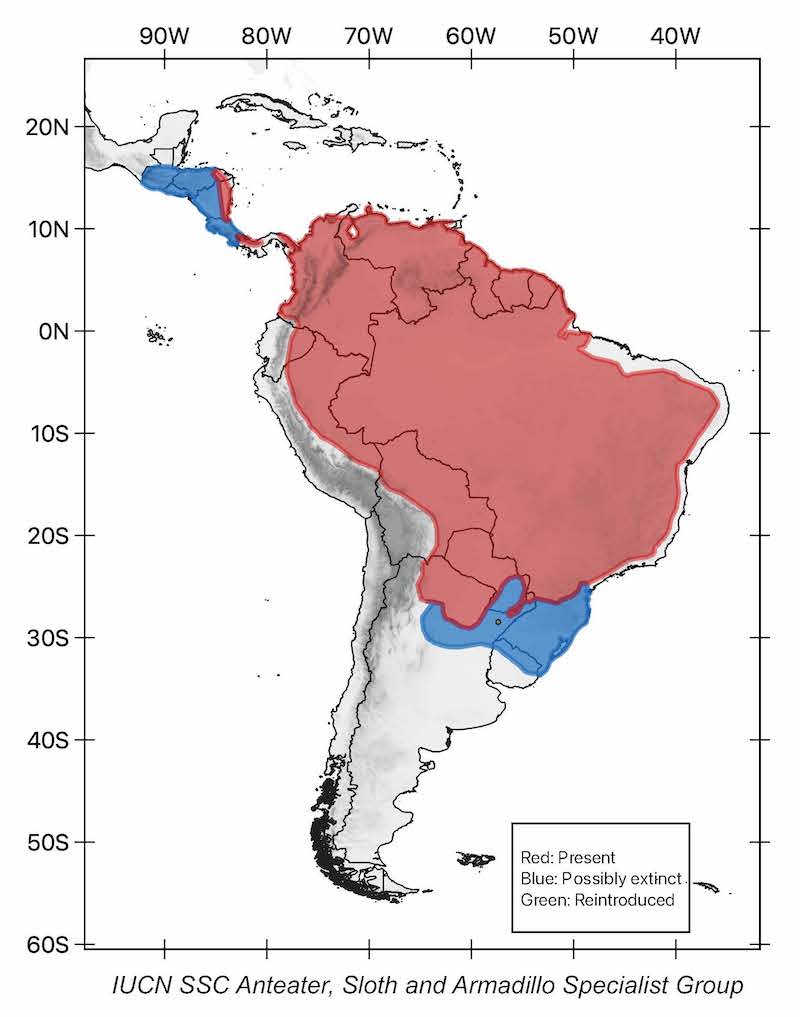Giant Anteater
(Myrmecophaga tridactyla)
other common names
Greater anteater
Ant bear
Taxonomy
Order: Pilosa
Family: Myrmecophagidae


description
With a head-body length of 1–1.4 m, a tail of 60–90 cm and a weight of 22–45 kg, this is the largest anteater species. Its most characteristic features are the elongated head with a small, circular, toothless mouth; the small, rounded ears; and the long tail that is covered with long and brushy hair. The coarse hair covering the body varies from light to dark gray or brown to grizzled. A characteristic triangular band enclosed by white lines extends from the chest and throat to the anteater’s back, and the white forelegs sometimes bear a black band or spots. The forefeet have four digits, with the second and third bearing long, powerful digging claws.

diet
Giant anteaters feed primarily on ants and termites. They can ingest thousands of these insects per day. Occasionally, they also eat unusual items such as beetle larvae or honeybees that maintain their colonies in termite mounds.

range
Giant anteaters occur from northeastern Honduras in Central America, south through the lowlands of South America to the Gran Chaco region of Bolivia, Paraguay and Argentina. Within Central America, the species has disappeared from much of its range, with recent sightings generally confined to highland regions. The giant anteater is considered the most threatened mammal of Central America; it seems to be extinct in Belize and Guatemala, and has disappeared from parts of Costa Rica. In South America, this species seems to be extinct in Uruguay and in the state of Santa Catarina, Brazil.

Population trend
Decreasing.

curious facts
Giant anteaters walk on their knuckles like some primates. They can extend their long, worm-like, sticky tongue between 35 and 40 cm.

threats
The giant anteater is at risk of extinction due to habitat loss in large parts of its range, and this is a significant threat to Central American populations in particular. Where this species inhabits grassland habitats (especially where termite mounds can be found at high densities) it is particularly susceptible to fires. Although they are a natural process in part of the species range, these fires have increased in intensity and frequency. In addition, intentional wildfires to transform forests and grasslands to pasture management for cattle as well as land use change for agroindustry areas to plant soy beans and other crops are increasing in several countries, especially in Brazil and Bolivia, and the number of giant anteaters burned is high. The subpopulation in the Pantanal of Brazil has suffered significant declines due the direct and indirect effects of intentional fires.
Urban sprawl is also a problem, as it is causing the species to appear on the streets of large cities. Animals are sometimes attacked by dogs. In some parts of their range, giant anteaters are occasionally hunted for food, and are additionally caught in the wild to be kept as pets or for the illegal trade. In Bolivia there is evidence that illegal traffickers of jaguar fangs are also demanding giant anteater claws. In Guyana, they are killed for use as a medicine and for reasons of superstition, as some people believe they bring bad luck; there also seems to be some illegal international trade.
Environmental contamination may also represent a threat, as high levels of mercury have been found in the blood of giant anteaters from Brazil.

HaBITAT and ECOLOGy
This terrestrial anteater is found in tropical moist forest, dry forest, mangroves, swamp and marsh forests, savanna habitats and open grasslands. It has also been reported from the Gran Chaco, timber plantations, and areas in regeneration after having been used for agriculture and cattle ranching. It is locally uncommon to rare. It seems, however, to be relatively common in the Argentine Chaco region, where its main predator is virtually extinct.

reproduction
Giant anteaters become reproductively active between 1.8–4 years of age. A single offspring is born after a pregnancy of around 6 months. Mothers carry their offspring on their backs for several months. The young become independent at 8–9 months of age.

conservation status
This species is listed as Vulnerable on the IUCN Red List of Threatened Species. It is widespread geographically, but there have been many records of local extinctions, especially in Central America (where it is considered the most threatened mammal) and the southern parts of its range. The low reproductive rates, large body size, along with threats to habitat loss aand degradation in many parts of its range, have proved to be significant factors in its decline. The giant anteater is currently listed in a threat category in virtually all regional and national Red Lists. A population loss has been estimated based on local extinctions, habitat loss, and deaths caused by fires and road kills. Based on this decline and past threats that are still ongoing today, it is likely that the population has suffered an overall reduction in population size of at lest 30% but less than 50% over the last three generations (suspected to be around 21 years).